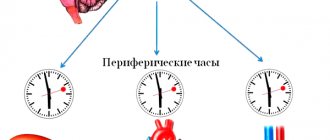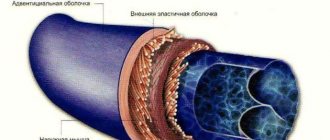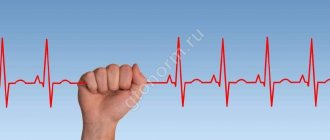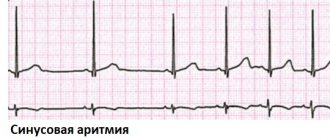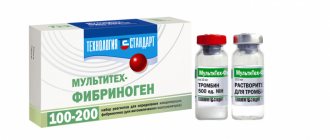Modern diagnostic technologies in medicine make it possible to more efficiently and effectively examine the entire body and find hidden diseases, congenital pathologies and neoplasms that appear throughout a person’s life. Daily ECG monitoring (Holter) or daily Holter recording is a diagnosis that consists of continuous recording of the electrical activity of the heart.
Features of daily ECG monitoring (Holter)
Holter ECG monitoring or Holter ECG appeared in medicine back in the mid-90s. The study consisted of monitoring heart function. The technique and equipment for the procedure were developed by American biophysicist Norman Holter.
Now the Holter ECG is considered one of the most reliable diagnostics for disturbances in the electrical activity of the heart throughout the day, in the conditions of the patient’s usual day and night. A special device is attached to the patient's body, it is called a portable recorder, which continuously records the ECG through electrodes that are placed on the patient's chest.
This diagnosis allows us to detect any cardiac dysfunction. Using the technique, it became possible to timely identify serious pathological changes that could not be detected during a routine examination by a cardiologist or when recording a routine ECG.
Content:
- Features of daily ECG monitoring (Holter)
- What is the difference between a regular ECG and a Holter ECG?
- When is Holter ECG prescribed?
- Types of Holter ECG monitoring
- Stages of preparation for the examination and features of its implementation
- Decoding the results
The patient carries the equipment in a special case. The study will not interfere with your usual lifestyle and will not cause any discomfort or discomfort. The patient should record any changes that occur in his health. The information is recorded on paper, indicating the exact time of the deterioration and the background against which this deterioration occurred.
The main advantages of diagnostics: a modern device records a huge amount of data, the analysis of which will make it possible to make a correct diagnosis; the device will detect any heart pathologies; thanks to the device, it is possible to promptly identify the daily number of rhythm disturbances, the type of rhythm and conduction disturbance, and ischemic signs; Conducting the study under familiar conditions will provide correct and reliable readings of heart function, since this eliminates additional stress.
After diagnosis
The analysis of the received recording is carried out on special decoder computers. When deciphering, information about the heart rhythm is indicated: its source and frequency; information about rhythm disturbances: supraventricular and ventricular extrasystoles, paroxysms of arrhythmias; information about rhythm pauses; information about changes in the PQ and QT intervals, if these changes occurred, information about changes in the morphology of the QRS complex caused by intraventricular conduction disorders; information about changes in the final part of the ventricular complex (ST segment) and the connection of these changes with the patient’s physical activity and his feelings according to the diary; information about the operation of the artificial pacemaker - if there is one. Identified features or pathology can be illustrated with ECG printouts for the corresponding monitoring period.
What is the difference between a regular ECG and a Holter ECG?
If we compare conventional electrocardiography with 24-hour monitoring, the first research method will be less informative and reliable. ECG is a recording of cardiac activity, which is carried out for 15-30 seconds in a state of complete rest. With its help, you can see the electrical processes in the heart, but only in a short period of time.
Standard electrocardiography will not be able to detect hidden cardiac pathologies that do not manifest clinically and are not recorded during recording by the device in resting states, or appear at an unspecified time during the day. As a result of a conventional study, it is impossible to see the functioning of the heart during eating, intense physical activity, sleep and rest.
Also, the correctness of the ECG results can be affected by the patient’s stressful state. This is due to the fact that during stress, phenomena will be present on the cardiogram that can be misinterpreted as pathology. Due to unreliable results, an incorrect diagnosis may be made, then treatment will be ineffective and even dangerous to human health.
Daily monitoring (Holter) will help identify disturbances in the functioning of the heart that are “transient” in nature (coronary heart disease, disturbances in heart rhythm and cardiac conduction). The duration of diagnosis depends on what abnormal and pathological phenomena the attending physician suspects.
To conduct a daily study, a portable recorder is used, which records all cardio readings. Modern devices can record not only cardiac indicators, but also blood pressure, respiratory indicators and others. This technique is allowed even for pregnant women and the elderly. ECG monitoring is indicated for all patients who have detected disturbances or abnormalities in the functioning of the heart.
How to wear a halter correctly
During the diagnostic period, it is necessary to ensure that the device is not overcooled and does not come under the influence of a magnetic field. You need to follow your doctor's recommendations and ensure that the electrode is firmly attached to the body. In rare cases, the cardiologist decides to use a portable recorder for diagnosis, recording data “on demand”.
It is very important to understand how to remove a halter correctly. You need to check with your doctor in advance about the order in which you should proceed. In most cases, it is enough to simply peel off the sensors and remove the device. Even when the battery is disconnected, the received data remains in memory.
When is Holter ECG prescribed?
The Holter research method is recommended for people of all ages, including pregnant women. Fainting, dizziness, discomfort in the heart area, attacks of irregular heart function, palpitations, shortness of breath - all these symptoms are subject to daily Holter ECG monitoring.
In relation to the established nosology, this diagnostic procedure is indicated for the following diseases:
- heart defects;
- diseases of the endocrine system;
- obesity;
- acute or chronic heart failure;
- previous myocardial infarction;
- arterial hypertension;
- hypertension that is not amenable to therapeutic treatment.
It is also advisable to do a Holter ECG to monitor the operation of the pacemaker.
How long does the monitor last and what are 12 channels?
Since the wearable recorder has an autonomous power source, the length of time the monitor is worn, the number of electrodes used, and the abundance of ECG abnormalities (artifacts) during continuous recording affect battery depletion. As a rule, during the initial assessment, cardiologists record up to 12 channels (12 channels are a simulation similar to a regular ECG) with a wearing period of 1 to 2 days, if necessary.
It is clear that multi-day recording, in order to prevent premature discharge of the power source, is carried out with a limitation on the number of recorded channels, which does not reduce the value of the study for arrhythmias, but limits the possibility of assessing ischemia.
The practice of the A-Media Family Clinic, with multi-day recording in the case of a more thorough search for ischemia, has developed a rule for recording all 12 ECG channels with the patient coming to the Center every 1-1.5 days to view the recording and resume the battery operating mode.
Types of Holter ECG monitoring
Nowadays, a 24-hour examination is the best way to conduct a general diagnosis of the body and health status. The survey can be carried out in 2 ways: full-scale and fragmented.
The fragmentary method is used when a person has an arrhythmia. If the patient begins to feel discomfort, pain in the chest, or a general deterioration in health, he presses the button of the device and the recording of cardiac parameters begins.
A full-scale diagnostic method lasts for at least 1 day and maximum 1-2 weeks. An ordinary cardiogram will not provide as complete data as the method of the famous American biophysicist.
The doctor can assign several tasks to the patient, the results of which will be recorded by the device. For example, a patient needs to go up to the 7th floor, then go down. At this time, the recorder will record heart function indicators, which will determine the patient's health status.
How should you prepare for a HM study?
All equipment is protected from interference and does not require any special restrictions, except for the patient’s clothing. Here we recommend that during the period of the study you wear underwear that does not cause static electricity - without wool and synthetics, optimally cotton and linen. Women should wear short shirts when installing a monitor with an external cable and a bag. On the contrary, a “wireless” monitor does not limit the length of clothing. When installing a blood pressure monitor, outerwear should not have tight sleeves. Men with thick chest hair should not shave it themselves; we will do this during placement.
The specifics of the study, medications, and proposed samples will be brought to your attention when installing the monitor.
Stages of preparation for the examination and features of its implementation
In order for the technique to show reliable results, the patient should prepare for a procedure that will last for 24 hours or 3 or more days. Before the procedure, it is necessary to take a shower, because during the examination the patient must not remove the equipment or wet it with water. You should remove metal jewelry and accessories (watches, earrings, pendants), as metal negatively affects the accuracy of cardio readings. During the procedure, you need to wear comfortable clothes, preferably cotton.
For proper operation of the device, water should not be allowed to get on the equipment; contact of the equipment with other devices that create magnetic fields around them should be avoided. You must carry the recorder carefully so as not to damage its integrity: you must not drop or hit it.
The equipment consists of 2 parts - a stationary decoder and a recording device that takes readings. The electrodes are fixed to the skin.
A full-scale heart study is carried out while the patient leads his usual lifestyle, prepares food, runs, sleeps, eats, and rests. Everything that the patient does during the monitoring process is recorded in the diary. The time spent on a specific action is recorded. You can characterize your condition using three indicators: worsened, improved, or remained unchanged.
Rules and recommendations during a Holter ECG: first, you should not exhaust yourself with physical activity, because there is a risk that the electrodes will detach from the skin and the diagnostic results will be inaccurate: second, the patient should avoid stressful situations; third, it is undesirable to travel, fly on an airplane or go on attractions during the examination; fourth, the device should not be exposed to strong temperature changes; fifth, you should protect the recorder from moisture and water.
The patient should lie on his back so that the location of the electrodes is not disturbed. If your back hurts, you can turn over on your side, but at the same time monitor the operation of the device. This technique is considered safe; it does not cause complications or pathological changes. Cardiac registration should not be prescribed to people with high blood pressure, left ventricular diastolic dysfunction, organ dysfunction, acquired heart defects, asymptomatic myocardial ischemia, angina pectoris (chest discomfort).
Best materials of the month
- Coronaviruses: SARS-CoV-2 (COVID-19)
- Antibiotics for the prevention and treatment of COVID-19: how effective are they?
- The most common "office" diseases
- Does vodka kill coronavirus?
- How to stay alive on our roads?
What measurements does Holter take?
- Electrocardiogram recording;
- Determination of heart rate, including the maximum and minimum number of heart rates per minute, as well as the average heart rate;
- Recording physical activity and rest (actiography);
- Blood pressure measurement (modern Holter recorders allow ABPM to be carried out simultaneously with a study of cardiac activity.
You can sign up for Holter monitoring in our clinic right now, and receive a detailed report within 24 hours!
